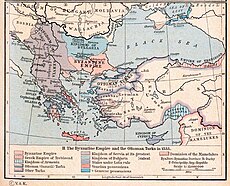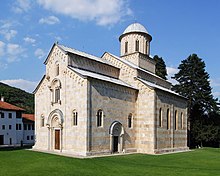
A | B | C | D | E | F | G | H | CH | I | J | K | L | M | N | O | P | Q | R | S | T | U | V | W | X | Y | Z | 0 | 1 | 2 | 3 | 4 | 5 | 6 | 7 | 8 | 9
| History of Serbia |
|---|
 |
|
|



The medieval period in the history of Serbia began in the 6th century with the Slavic migrations to Southeastern Europe,[1] and lasted until the Ottoman conquest of Serbian lands in the second half of the 15th century.[2] The period is also extended to 1537, when Pavle Bakić, the last titular Despot of Serbia in Hungarian exile, fell in the Battle of Gorjani.[3]
At the time of settling, Serbs were already transitioning from a tribal community into a feudal society. The first Serbian state with established political identity was founded by prince Vlastimir in the mid-9th century. It was followed by other Serbian proto states, unstable due to the constant clashes with the Bulgarians, Hungarians and Byzantines, and by the conflict between Rome and Constantinople regarding the Christianization with the Byzantines getting the upper hand in the 9th century.[4][5][6]
By the second-half of the 10th century Principality of Serbia, enlarged but unconsolidated, prone to the internal tribalism and foreign attacks, collapsed leaving Serbian lands to the plunderers.[4][5] Serbian statehood moved to Duklja, which at one point reunited almost all Serbian lands, but the Byzantines successfully sidelined it.[5][6][7] The stable, unified, and continuous Grand Principality of Serbia was established in the late 11th century by Vukan. While under the rule of Stefan Nemanja and his descendants, the Nemanjić dynasty, Serbia achieved its Golden Age which lasted until the 14th century, when as a powerful state (kingdom from 1217, empire from 1346), it dominated the majority of the Balkan peninsula.[4]
By the 14th century, Serbia was a fully developed feudal state.[5][7] Foundations were set by King Milutin (1282-1321), the most important Serbian medieval ruler, who halted expansion of state in 1299 in order to consolidate it.[6][7] Serbia peaked during the reign of king and later Emperor Dušan (1331-55). He expanded the state to encompass modern Serbia south of the Sava and the Danube, Macedonia, Montenegro, Albania, east Herzegovina, Epirus and Thessaly, organized Serbia after the Byzantine Empire, and introduced codified law.[4]
There was a tight union of state and church which became autocephalous in 1219 under Saint Sava, and a patriarchate in 1346, rivaling the status of Ecumenical Patriarchate in Constantinople. The rulers endowed numerous monasteries, like Mileševa, Peć, Morača, Sopoćani, Visoki Dečani, Gračanica, which are today monuments with an important symbolism for Serbs. The union accelerated cultural development and moved beyond the realm of simply translating Byzantine works and established a unique Serbian civilization. Political and cultural growth was followed by economic growth. Agriculture developed; and while silver, tin and copper had been mined during the Roman era, mining vastly expanded in this period. Trade boomed as well utilizing old Roman roads.
The apex was short-lived. Dušan's death was followed by disintegration of state under rival family branches and local leaders.[4] The last emperor, Uroš, died in 1371. The major pretender to the unified throne was King Vukašin, but he died clashing with the Ottomans in 1371. The next who appeared able to restore Serbia was Prince Lazar Hrebeljanović, ruler of the expanded Moravian Serbia.[6] The major clash with advancing Ottomans occurred on 28 June 1389 at Kosovo Polje. Both rulers, Sultan Murad I and prince Lazar, were killed in the battle. Due to its importance, magnitude, and consequences, the battle, its participants and circumstances were enshrined and immortalized in folk poetry and literature. It transcended the historical importance, reaching a spiritual level by the 19th century, and turned Kosovo into the "Jerusalem of the Serbs".[4] Despite the defeat,[5] Serbia endured for another 70 years, experiencing a territorial and cultural revival under Despot Stefan Lazarević (1389-1427).[6][7] Serbian resistance continued until the fall of Smederevo in 1459.[4]
Despite the claimed significance in which Turkish rule shaped national consciousness of the Serbs, the fall under the Ottomans was dubbed by the Serbian historians as “Turkish night”.[4] The conquest severed continuity of economic, social and political development,[7] and Serbia was cut off from the European cultural and political society where it was carving its own place. When development of Serbia and the rest of Europe in the 15th and the 19th century are compared, it shows the enormous erosion and falling behind.[8]
Introduction
Background

During the 6th century, at the beginning of the early medieval period, territory of later Serbia was controlled mainly by the Byzantine Empire (southern and central regions), and also by Byzantine neighboring rivals, the Gepid Kingdom and the Ostrogothic Kingdom (northern regions). During the reign of Byzantine emperor Justinian I (527–565), defensive structures in the region were reinforced.[9] In 535, the newly founded city of Justiniana Prima became center of the Archbishopric of Justiniana Prima, with metropolitan jurisdiction over all provinces of the Diocese of Dacia.[10] At the beginning of the 7th century, region was invaded by Avars and Slavs, thus ending the Byzantine rule.[11]
Slavic settlement


The Slavs in general were mentioned by the Roman historians Tacitus and Pliny the Elder and by Claudius Ptolemy, under the name Veneti in the 1st and 2nd century AD. In the 6th century, Byzantine author Procopius and Gothic historian Jordanes mention them as Sclaveni. By this time, the Slavs already settled in the wide areas of central and eastern Europe, reaching lower and central Danube regions and invading Byzantine territories from Thrace, throughout Illyricum, up to Pannonia and Dalmatia.[12][13]
De Administrando Imperio ("On the Governance of the Empire", DAI), compiled by the Byzantine Emperor Constantine VII Porphyrogenitus,[14][15][16] mentions that the White Serbs relocated from the land of Bojka, also called the White Serbia. Historiography can't pinpoint for sure where that is, but the general consensus is that it was around the region of Bohemia (Boihaemum = Bojka) and Saxony.[17][18][19][20][21][22][23]
After a death of the Serbian prince, his two sons took over the rule and divided White Serbs in two groups. One remained in White Serbia, while the other group migrated to the Balkans.[24][25] Frankish Chronicle of Fredegar mentions Dervan, chieftain of the Serbs, in c. 631, who may be the first Serb mentioned by name in history. Dervan is considered to be the father or, more likely, brother of the nameless prince who led the White Serbs into the Balkans.[26][27][28]
Sclaveni raided and settled the western Balkans in the 6th and 7th century.[29] Jointly with the Antes, another Slavic group, they conducted intrusions south of the Danube and Sava rivers into the Balkans, and the territory of the Byzantine Empire ruled by Justinian I (527-565), who almost revived the Roman Empire. The arrival of the Avars in the Pannonian Plain in 567 pushed the proper invasion raids. The Slavs followed the Avars in their, mostly destructive enterprises, into the Byzantine territory. They destroyed and conquered one by one city and fortress which constituted the Danubian Limes, northern border of the empire, like Sirmium (582) and Singidunum (modern Belgrade, 584). In 584 and 586 the Slavs already besieged Thessaloniki, on the Aegean Sea, raided Dalmatia in 597 while the entire limes collapsed by 602.[30][31][32][33]
The decisive phase followed, mostly from 610 to 626, when the Slavs raided the inland of the Balkans, destroying large cities and ravaging the area between the Danube on the north and south of Greece, including the repeated sieges of Thessalonica in 616 and 618, and of Constantinople itself in 626. Only defeat at Constantinople stopped the raids and pacified the situation on the peninsula, but by that time large portions of the Balkans were already inhabited by the Slavs.[34][35]
Around 640, the Avar-Slavic party raided the city of Salona on Dalmatian Adriatic coast, capturing Christian residents and numerous religious artifacts, including relics of the Saint Domnius and Saint Venantius of Salona. Pope John IV sent abbot Martin to buy off the prisoners and relics, whose account on the event survived. At the same time, citizens of the neighboring Spalatum complained to the "emperors in Constantinople" (Heraclius and his son Heraklonas) about the constant harassment by the Slavs, which prompted the emperors to issue an order to the "Goths and Slavs" to leave the town alone, which they complied to. The 8th century History of the Lombards by Paul the Deacon tells about the Slavic flotilla which attacked the town of Sipont in Italy in 642 (or 646). The Slavs arrived with "many ships", landed on the Gargano Promontory, close to Sipont, where they set their tent camp. They confronted the Lombards' duke Aiulf I, killing him. They were then approached by the Aiulf's adopted younger brother Radoald who "spoke their language", confusing the Slavs long enough to defeat them and expel them from the Apennine Peninsula.[36]
Unlike some later attacks on modern Italian soil, it is unknown which specific Slavic tribe conducted this excursion. However, with some other data (Italian monks claim that Slavs acknowledged paramount rule of the Byzantine emperor), the well equipped attack on the Lombards, main opponents of the Byzantine Empire in Italy, points to the close connections between the Slavs and the Byzantines and the Byzantine overall influence, corroborating the DAIs claim that Serbs settled in the Balkans in accordance with the Byzantine emperor.[37]
Main remains of the Slavic culture and social organization, from the 7th to the 9th century, includes several localities around Doboj and in the Drina river valley, in modern Bosnia and Herzegovina, especially the large settlement near the village of Batković. The settlement had furnaces for the ore melting and smithing workshops.[38]
Apart from the Serbs and the Croats, some of the Slavic tribes which settled the Balkan peninsula included:[39][40]
| Tribe | Serbian name (modern) | Regions | Modern states |
|---|---|---|---|
| Eastern Obotrites | Бодрићи (Bodrići) | Braničevo | Serbia |
| Braničevci | Браничевци (Braničevci) | Braničevo | Serbia |
| Baiounitai | Вајунити (Vajuniti) | Epirus | Albania, Greece |
| Belegezites | Велегезити (Velegeziti) | Thessaly | Greece |
| Berziti | Брсјаци (Brsjaci) | Lake Ohrid | North Macedonia |
| Drougoubitai | Драгувити (Draguviti) | North Macedonia | Bulgaria, Greece, North Macedonia |
| Ezeritai | Језерити (Jezeriti) | Central Peloponnese | Greece |
| Guduscani | Гачани (Gačani) | Lika-Dalmatia or Timok Valley | Croatia or Bulgaria-Serbia |
| Melingoi | Мелинзи (Melinzi) | East Peloponnese
Zdroj:https://en.wikipedia.org?pojem=Medieval_Serbian_state Text je dostupný za podmienok Creative Commons Attribution/Share-Alike License 3.0 Unported; prípadne za ďalších podmienok. Podrobnejšie informácie nájdete na stránke Podmienky použitia.
Analytika
Antropológia Aplikované vedy Bibliometria Dejiny vedy Encyklopédie Filozofia vedy Forenzné vedy Humanitné vedy Knižničná veda Kryogenika Kryptológia Kulturológia Literárna veda Medzidisciplinárne oblasti Metódy kvantitatívnej analýzy Metavedy Metodika Text je dostupný za podmienok Creative
Commons Attribution/Share-Alike License 3.0 Unported; prípadne za ďalších
podmienok. www.astronomia.sk | www.biologia.sk | www.botanika.sk | www.dejiny.sk | www.economy.sk | www.elektrotechnika.sk | www.estetika.sk | www.farmakologia.sk | www.filozofia.sk | Fyzika | www.futurologia.sk | www.genetika.sk | www.chemia.sk | www.lingvistika.sk | www.politologia.sk | www.psychologia.sk | www.sexuologia.sk | www.sociologia.sk | www.veda.sk I www.zoologia.sk |
